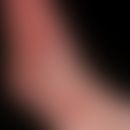DefinitionThis section has been translated automatically.
Pathological changes of the nail organ
The pathological changes of the nail plate(onychodystrophy) itself are manifold and are based on very different causes. Basically, onychodystrophies can only be caused by changes in the nail plate itself (e.g. matrix damage), in the nail bed (e.g. so-called oil stain in psoriasis) or by changes in the immediate vicinity of the nail (e.g. dorsal cyst with localised nail dystrophy; unguius incarnatus).
ClinicThis section has been translated automatically.
Since the nail plate itself consists of a "dead" horn plate, all changes in the nail plate are already created in the nail matrix. Only there is the nail inscribed "like with a printer"; the engraved disorder then moves forward with the nail growth and becomes clinically visible. The time interval between the appearance of the disorder and its becoming visible must always be considered. Basically, different types of disturbances of the matrix lead to defined pathological changes of the nail plate.
Note:
Short lasting circumscribed disorders lead to a spot in the nail plate (e.g. spotted nails).
Long lasting circumscribed disorders lead to a line in the nail plate (e.g. Melanonychia striata longitudinalis).
Short-lasting disturbances of the entire matrix lead to a transverse line in the nail plate(Meess' transverse bands).
-
Long lasting disturbances of the entire matrix lead to complete disturbance (dystrophy) of the nail plate(psoriatic onychodystrophy).
The degree of severity of matrix damage also leads to different "labeling" of the nail plate.
Short-lasting, mild and superficial circumscribed disorders lead to punctate parakeratotic keratinization of the nail plate. When the nail plate grows out, the parakeratotic material breaks out, a dimple (Pitts) is formed.
Short-lasting, mild, circumscribed disturbances deep in the nail matrix also lead to punctate parakeratotic keratinization of the nail plate. However, this parakeratotic nest is covered by normal nail material. When the nail plate grows out, punctate or cloudy white patches are found.
Short-lasting, severe disruption of the entire matrix results in a transverse groove of varying depth in the nail plate.
Intermittent, severe disturbances of the entire matrix result in a variably deep, transverse groove pattern (wave pattern) in the nail plate.
Prolonged, circumscribed severe disturbances of the matrix result in a variably deep, longitudinal groove pattern in the nail plate.
- Atrophy of the entire nail matrix leads to severe atrophic disturbances of the nail plate up to nail baldness(anonychia).
Change of the nail shape
Nail shape is subject to considerable physiological fluctuations without any disease value. However, some changes are clearly definable and can possibly be assigned to certain diseases. They are therefore of differential diagnostic interest.
- Clock glass nails and drumstick fingers. These are rounded nails with simultaneous hypertrophy of the nail bed. The nail is convex like a watch glass. Drumstick fingers occur hereditarily, but more often in association with chronic obstructive pulmonary disease. They are also a leading symptom in pachydermoperiostosis.
- Long narrow nails are found in Marfan syndrome.
- Short nails(brachyonychia), in which the nails are wider than long, result from nail biting, but are also seen in hypothyroidism and psoriatic arthropathy. Brachyonychia or racket nailsalso run in families.
- Koilonychia is commonly seen in neonates, may be associated with iron deficiency in adults, or may be idiopathic.
- Tubular and claw nails
Change in nail color
Since nails also contain melanin, their degree of pigmentation and thus color corresponds to ethnic origin. Brown-black discolorations of the nails(melanonychia) are often caused by circumscribed or diffuse melanin deposits in the nail plate . Mycoses caused by mold species can also cause black discolorations of the nail matrix, so that here differential diagnostic difficulties to melanocytic discolorations can occur (see below melanoma malignant acrolentiginous) .
Note: the darker the skin, the darker the nails (and hair!).
- Diffuse brown discoloration may be found after prolonged treatment with ACTH. Antimalarials (Resochin) can also cause nail pigmentation. The nail plate may also turn brown due to external influences, most commonly in smokers (simultaneous discoloration of the acral cuticle on fingers 1, 2, and 3).
- Streaky brown discoloration indicates circumscribed melanocytic processes in the nail matrix (e.g., melanocytic nevus or malignant melanoma).
- Differentially, traumatic hematomas of the nail bed should be separated. This differential diagnosis is by far the most important for the overall clinic of nail changes. Streaky red discoloration of the nail plate (erythronychia) may be isolated or multiple and is polyetiologic in nature (idiopathic, neoplastic, or inflammatory).
- Green nails are found in pseudomonas infections. Aspergillus or molds (often accompanying dermatophyte infection) cause patchy brown or green-brown, sometimes black discoloration. Candidaparonychia to yellow-brown and pure filamentous fungal infections to white-yellowish nails.
- White discoloration(leukonychia) of the nail plate is usually harmless. A total leukonychia of all nails is found in Leukonychia totalis (autosomal dominant); see also Bart-Pumphrey syndrome.
Note: With all the clinical diversity of nail changes, there are only 2-3 really important diagnoses and differential diagnoses to know at the crucial moment:
Traumatic hemorrhage vs. malignant melanoma.
Subungual carcinoma vs. subungual osteochondroma
Unguius incarnatus vs. amelanotic malignant melanoma
-
Onychomycosis vs. malignant melanoma
Few nail changes have therapeutic consequences. Congenital dystrophies are not treatable. In the case of nail changes in the context of systemic diseases or dermatological diseases, it is important to treat the underlying disease. The frequent age-induced nail changes usually remain therapeutically completely frustrated.
Outgoing links (11)
Anonychia (overview); Bart-pumphrey syndrome; Brachyonychia; Leukonychie; Meese cross bands; Melanoma acrolentiginous; Melanonychia; Melanonychia striata; Nail pitting due to psoriasis; Onychodystrophy (overview); ... Show allDisclaimer
Please ask your physician for a reliable diagnosis. This website is only meant as a reference.




